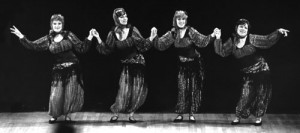BAGHDAD, Oct. 29 — The members of the national dance troupe of Iraq are performers without an audience. They rehearse daily, but hardly ever put on a show.
Yet each turn of the hip and dip at the waist in their choreographed pieces has become weighted with a dangerous new reality, even as they wait for the chaos around them to subside so they can perform again. In today’s Iraq, with conservative religious parties and radical militias exerting growing influence over every aspect of life, even dancing is an act of bravery.
“Society is overwhelmed by these religious ideologies,” said Tariq Ibrahim, a male dancer in the Baghdad troupe, the Iraqi National Folklore Group. “Now a woman on the street without a head scarf attracts attention. What about a woman onstage dancing?”
Together they are a band of 10 women and 15 men from varied religious backgrounds. Once they toured the world together. Today they are simply trying to survive, hoping one day to thrive again as a troupe. But the religiosity sweeping Iraq does not bode well for their future.
Female participation in folk dancing is considered haram, or forbidden, in Islam. Ayatollah al-Sistani, the leading Shiite cleric in Iraq, has issued strict guidelines against dancing in various situations. The country’s Shiite-led government, the dancers said, is naturally trying to marginalize them.
“Religion in its essence does not match with art,” said Fouad Thanoon, the group’s director and lead choreographer. “So when religion and government come together, that will affect art very much.”
The group has more immediate worries about extremists. Recently one of its members, Bushra Yousif, 21, a petite woman with delicate features who has been with the group for six years, received a note at home warning her to leave within 48 hours. A bullet was included in the envelope.
She was probably singled out because of her profession, she said, but she will continue to attend rehearsals every day. She loves dancing too much, she said describing it as the highest form of art to “deliver a message through your body.”
“Dying for this group would be like being martyred,” she said, adding that it is a risk she accepts.
The group, which began in 1971, is dedicated to preserving the folk-dancing heritage of Iraq, performing traditional dances drawn from across that country’s history and geography. The troupe’s first two decades were golden years, when dancers trained with master instructors from overseas and frequently went on international tours. In 1980 the dancers performed at the United Nations in New York and visited Paris. They have gone to Italy, Japan and China — 60 countries in all — and won numerous prizes along the way.
The economic sanctions imposed by the United Nations in the early 1990s brought most of that to a halt. But just a year before the American-led invasion in 2003, the group enjoyed a rebirth with a burst of freedom under Saddam Hussein’s government, performing almost every week here.
“The audiences were huge,” Mr. Thanoon, the group’s director said. “The theaters were overbooked.”
But the group has been in suspended animation since the invasion began. It has performed just four times in Iraq and made two brief trips to Jordan and Dubai since 2003. The violence that surrounds it makes holding performances impossible.
“It is absurd,” Mr. Ibrahim said. “It is not logical to have a performance group that only practices.”
Maysoun al-Damalouji, an outspoken secular member of Parliament who was the Iraqi government’s senior deputy minister of culture until March, said she had worried about being able to protect the dancers, as well as others involved in artistic endeavors that were objectionable to certain religious groups.
“The dancers were not the only ones,” she said. “We were worried about having fashion shows because we had to protect the models. We found we couldn’t really do that. The best way of protecting them was not to have them shown in public.”
The dance troupe had mainly supported itself with ticket sales before the fall of Mr. Hussein’s government, but when performances ended that became impossible. The current government has not compensated for that loss, the dancers said. They receive tiny stipends, amounting to about $140 a month, but even that is not guaranteed. The money often does not come and is usually barely enough to cover each dancer’s rent. Because the dancers rehearse every day from 9:30 a.m. to 1:30 p.m., it is almost impossible for them to get second jobs.
The present government, controlled by conservative religious parties, cares little for the arts, Ms. al-Damalouji said, so it is not inclined to support groups like the dance troupe.
In this climate the dancers said they must censor themselves. The group recently played a small role in a theatrical production in support of the country’s national reconciliation plan, put on for some employees of the Ministry of Culture, but Mr. Thanoon advised his dancers, for their own sake, to minimize any shaking of their hips or shoulders. The result was a rigid routine that seemed more martial than elegant.
“It should be like this,” Liqaa Shukr said, demonstrating with plenty of gyrating flourish. “Instead it is like this,” she said, switching to the languid movements they wound up performing.
Certain folk dances have been eliminated completely from the group’s repertory for performances inside Iraq because they might be considered too provocative.
“We need to match what’s going on now, not stand out,” said Najwa Subhi, another female dancer.
Most of the women in the group go to elaborate lengths to hide their occupation from their neighbors, even though some of their faces are well known in Iraq from their performances on television under the old government.
Ms. Subhi, who lives in a mostly Shiite neighborhood dominated by militiamen, said she told her neighbors that she had quit her dancing and was working as a receptionist. She told them that even Hannah Abdullah, one of the group’s founders and Iraq’s best-known dancer, had retired.
“I spread this idea that we are no longer dancing,” she said.
On a recent trip to Jordan for a cultural festival, she had her husband load her luggage in the car in the middle of the night. Even her husband’s family did not know that she was going to perform. She told them she was visiting her brother in Kirkuk.
Rana Anwar, who successfully auditioned for a spot in the troupe three months ago, has let her neighbors and friends continue to believe that she is still a student at a tourism institute in Baghdad.
“It is very hard with what’s going on to become a dancer,” she said. “But my main goal is to show Iraq is not a backward country. Iraqi people like to dance, they like to sing.”
So the dancers continue to practice daily in front of empty seats at the National Theater in central Baghdad. The dilapidated hall has become their sanctuary from the country’s tumult.
Dumoaa Jamal was with the group for 10 years, but her uncle forced her to quit after the invasion because he deemed it too dangerous. But she returned three months ago, and tries to allay his fears by making sure she comes to rehearsals dressed in inconspicuous clothing and a head scarf hiding her long flowing hair.
“I wish it could be 24 hours a day,” she said about the group’s rehearsals. “When I enter the theater, it is as if everything from outside is gone. It is as if I have entered a different world.”
She feels like a bird on stage, she said. Later, when she has donned her head scarf, scrubbed the makeup from her face and stepped outside, reality returns. There is no more dancing, only walking as invisibly as possible.

